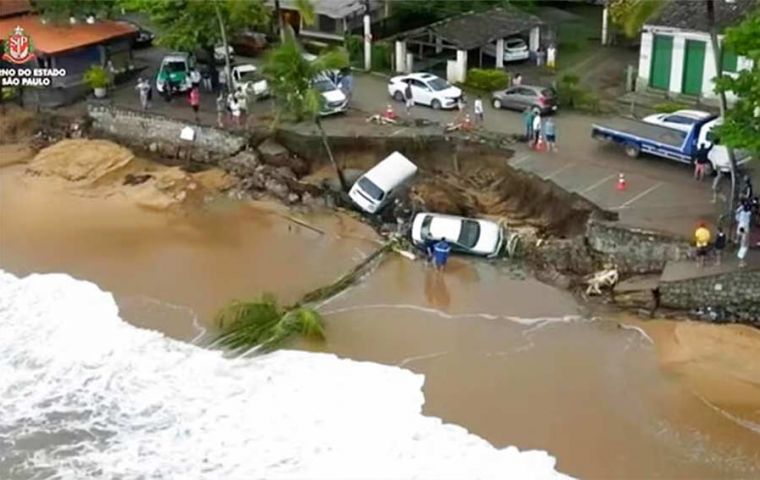MercoPress. South Atlantic News Agency
At least 13 killed in southeastern Brazil storm
 During the weekend, there was still the possibility of further damage such as falling trees and power poles, in addition to the destruction of houses on the coast.
During the weekend, there was still the possibility of further damage such as falling trees and power poles, in addition to the destruction of houses on the coast. At least 13 people died and 4 others were reported missing in southeastern Brazil Sunday due to storms and floods caused by the passage of an extratropical cyclone (low-pressure system), according to local authorities.
“The search continues,” Civil Defense said in a statement Sunday. The document also pointed out that five people who were missing had been found alive. The last two dead were from the town of Caraá, as were the four missing, it added.
Heavy flooding and landslides began Friday in the southeastern States of Rio Grande do Sul where 41 municipalities have been affected, with over 4,500 people forced to evacuate their homes, Globonews TV said.
President Luiz Inácio Lula da Silva announced the sending of federal aid to the area, while a team of ministers has traveled to the area to support Rio Grande do Sul Governor Eduardo Leite, Xinhua reported.
On Friday, Leite said through social networks that a 23-year-old person died in the city of São Leopoldo due to an electric shock, while five others were missing in neighboring municipalities. The landslides and floods have also caused the blockage of more than 15 highways, while more than a dozen flights were canceled at Porto Alegre's Salgado Filho airport.
The effects of the meteorological phenomenon have also been felt in the neighboring state of Santa Catarina, where dozens of people had to be evacuated from several localities, according to Globo.
The extratropical cyclone is a system of low atmospheric pressure that appears outside the tropics. It is associated with cold fronts and found at medium and high latitudes. In the Southern Hemisphere, cyclones rotate clockwise, according to the National Institute of Meteorology (Inmet) and the Center for Weather Forecasting and Climate Studies (Cptec), Agencia Brasil explained.
The cyclone that hit the south of the country - associated with a cold front - formed in the Atlantic Ocean during the week. The area of low pressure in the medium and high levels of the atmosphere enhanced the formation of the cyclone on land, transporting moisture from the ocean to the continent.
When the cyclone approaches the continent, the possibility of damage increases, with landslides and heavy rain and winds. “This is what brings greater risk, with excessive rainfall, very high accumulations, and strong winds,” meteorologist Estael Sias said in a video published on MetSul's channel.
Wind gusts exceed 80 km/h in the South Region, as forecast by the National Institute of Meteorology - Inmet. Rainfall volumes exceed 100 millimeters (mm) in 24 hours. Besides the southern states, the phenomenon also affected areas of the state of São Paulo.
Leite also announced the transfer of R$ 1.1 million (around US$ 210,000) to five municipalities affected by the extratropical cyclone. He also warned about the forecast of more rain throughout the day and assured that the government was mobilized to meet the situation. The most affected cities were Itati, Dom Pedro de Alcântara, Maquiné, Moinhos do Sul, and Três Forquilhas, on the northern coast of Rio Grande do Sul.
Porto Alegre Mayor Sebastião Melo deployed emergency teams to attend to the problems caused by the storm. In his social networks, he asked the city's residents to avoid leaving their homes. Since Thursday, the extratropical cyclone passing through Rio Grande do Sul brought heavy rains and intense winds to Porto Alegre and other cities. “To those who have the possibility, we appeal to avoid leaving home due to the disruption caused by the cyclone,” he said.
In all, 146 points of the State's capital were affected by the storm and strong winds. With over 100 trees downed, most of them from the high-voltage network, the priority was the obstruction of roads, property entrances, and other risky situations, it was explained.
Many occurrences need to be dealt with in conjunction with the power company so that the management of trees attached to the power grid can be done. Many neighborhoods remain without power. On Friday there were 65 occurrences with total blockage of public roads caused by fallen trees, lampposts, or accumulation of water. Dozens of traffic signs were also damaged by the winds. The southern and northern areas of the capital were the most affected regions. Civil Defense is helping families who have been displaced and are being treated at the city's gymnasiums. Shelters and personal hygiene items have been supplied.
During the weekend there was still the possibility of further damage such as falling trees and power poles, in addition to the destruction of houses on the coast as waves were forecasted to be 3.5 meters high between Rio Grande do Sul and Florianópolis.




Top Comments
Disclaimer & comment rulesCommenting for this story is now closed.
If you have a Facebook account, become a fan and comment on our Facebook Page!